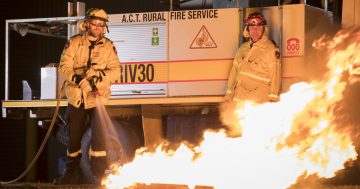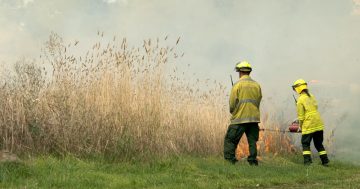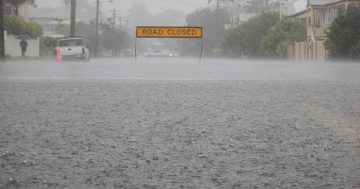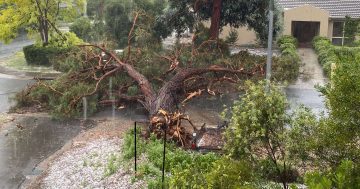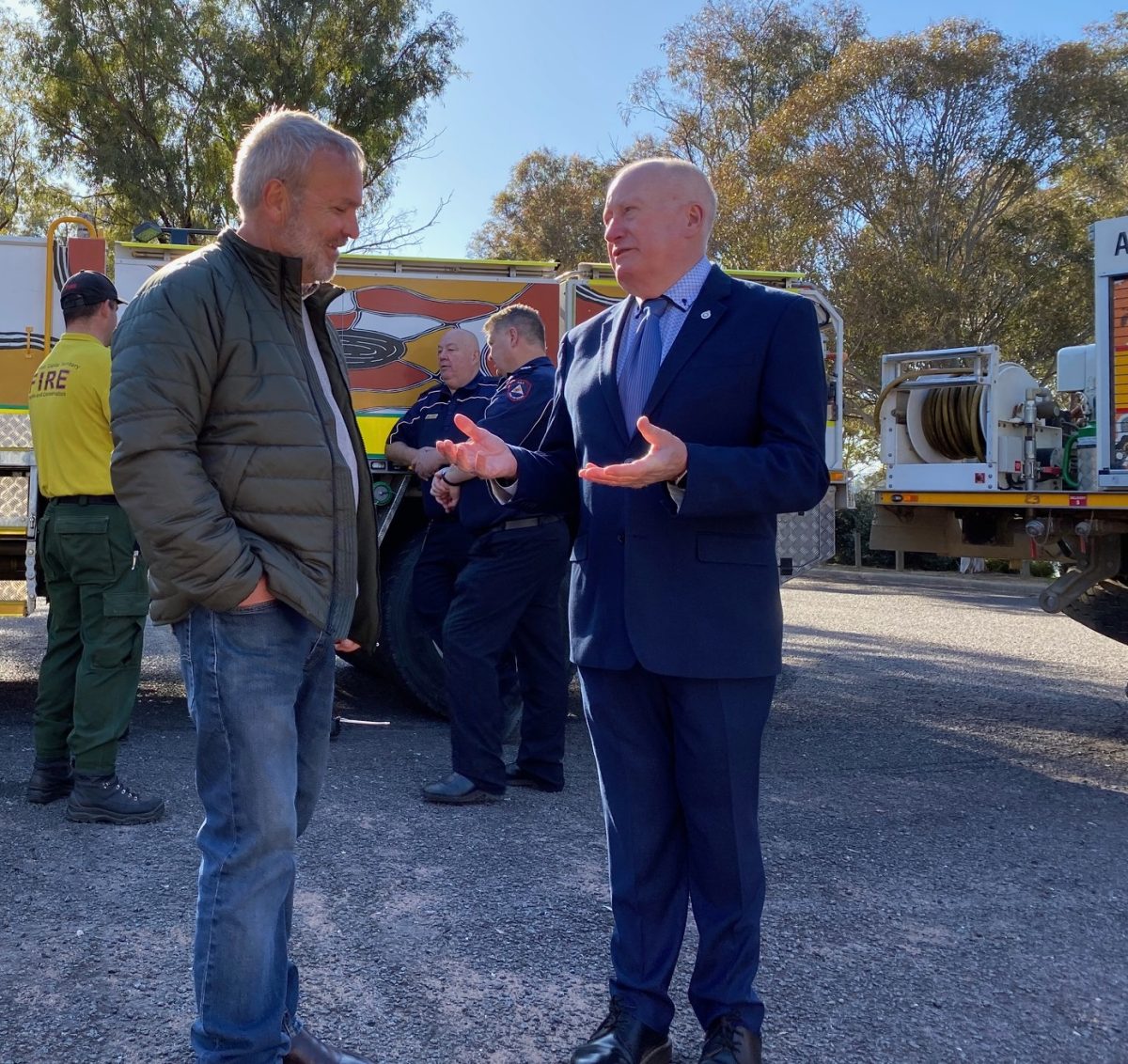
Caring on Country member Bradley Bell with emergency services minister Mick Gentleman, discussing bushfire risk management. Photo: Claire Fenwicke.
Indigenous knowledge and traditional learnings are playing a larger role in preparing for bushfire seasons as challenging conditions make modern methods more difficult to apply.
Ngunnawal Ngadjung project officer Bradley Bell is part of the Caring on Country initiative working out of Birrigai to teach Canberra’s salaried and volunteer firefighters about traditional practices such as cool burning.
The cultural practice, which is thousands of years old, involves setting fires at a much lower heat intensity than modern large-scale fuel reduction burns, meaning only the undergrowth is burned and the tree canopy remains protected.
“It’s really important that we all be able to work collaboratively and have an innovative look on how we can tackle this problem with bushfires moving into the future,” Mr Bell said.
“We all do know that we’re going to have a hotter, drier summer coming just around the corner.”
The team have been working with a number of rural fire units, giving firefighters the opportunity to learn the practice as well as giving the Caring for Country team insights into practices from a “Western science” point of view.
Mr Bell said cool burns meant the fires were more manageable and less likely to get out of control if weather conditions turned.
“At the end of the day, they [the firefighters] were really surprised the amount of country that we did reach through hazard reduction,” he said.
“We didn’t have to use an ounce of water. We didn’t have to rely on those units to protect against fire outbreak. So I think that was really important lesson for us all.”
Federal Emergency Management Minister Murray Watt joined ACT Emergency Services Minister Mick Gentleman to update the Canberra and Capital region community on what to expect this bushfire season.
We’ve already seen an unseasonably warm start to spring in southeast Australia, but Mr Watt said the previous wet years meant our soils were still saturated.
“The floods that we’ve seen over recent years have meant that there is still a lot of moisture in the ground, and that has made it a bit more challenging to prepare [for this bushfire season],” he said.
“We’ve known for some time that we were going to be facing a much more significant fire season this year than what we’ve seen over the last three or four years with the drier, hotter conditions that are emerging.
“Right through a number of coastal areas of NSW, but also Western NSW, we are facing above average fire risk in spring.”
When questioned by Region about what the government was doing at a national level to prepare, he said an extra aerial water bomber plane and additional helicopters were on hand, as well as improving communication between Federal and jurisdictional levels.
This included making sure there wasn’t an over-reliance on Defence to help.
“The reality is our Defence Force’s number one job is to keep the country safe from external threats,” Mr Watt said.
“[The government] always makes sure that the Defence Force is available when it’s needed, but what we need to do though is make sure that it’s a last resort rather than the first port of call.”
In terms of preparedness for the Territory specifically, Mr Gentleman advised a number of planned burns would be occurring in the coming weeks.
“We still have some moisture in our areas to the west and down to the south in Namadgi National Park, and so it’s been a bit of a challenge keeping some of that fuel load at bay,” he said.
“Our teams… have been out doing some fuel reduction burns to ensure that Canberrans can be safe this coming fire season.”
The ACT has also contracted one light helicopter with specialist intelligence gathering capability and two medium helicopters to provide dedicated aerial firefighting services to the Territory for the 2023-24 bushfire season.
The recent climate and water outlook from the Bureau of Meteorology has indicated there will be a high chance of below-average rainfall and above-average temperatures from October to December.
Mr Gentleman said this, combined with our above-average grass fuel loads in the ACT’s north-west, would increase the risk of grassfires in the summer months.
“While the Seasonal Outlook … indicates average fire potential for the ACT, we know that we can expect hotter and drier conditions heading into summer and must continue to be as vigilant as we can,” he said.
“Average fire potential does not mean that we are immune to risk, particularly in and around our grasslands to the north and west.
“[Also], forecast hot and dry conditions does not mean that we are immune from the risk of storms and flash flooding.”
Canberrans have also been urged to make sure their bushfire preparedness plans are up-to-date.
Upcoming planned burns can be found through ACT Environment. The Territory’s high-risk weather season begins on 1 October.













